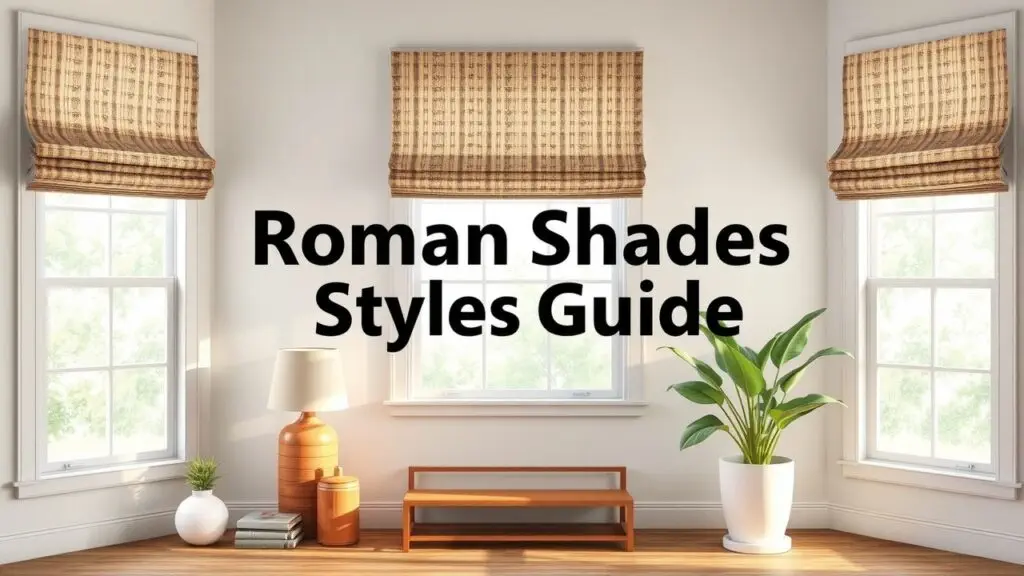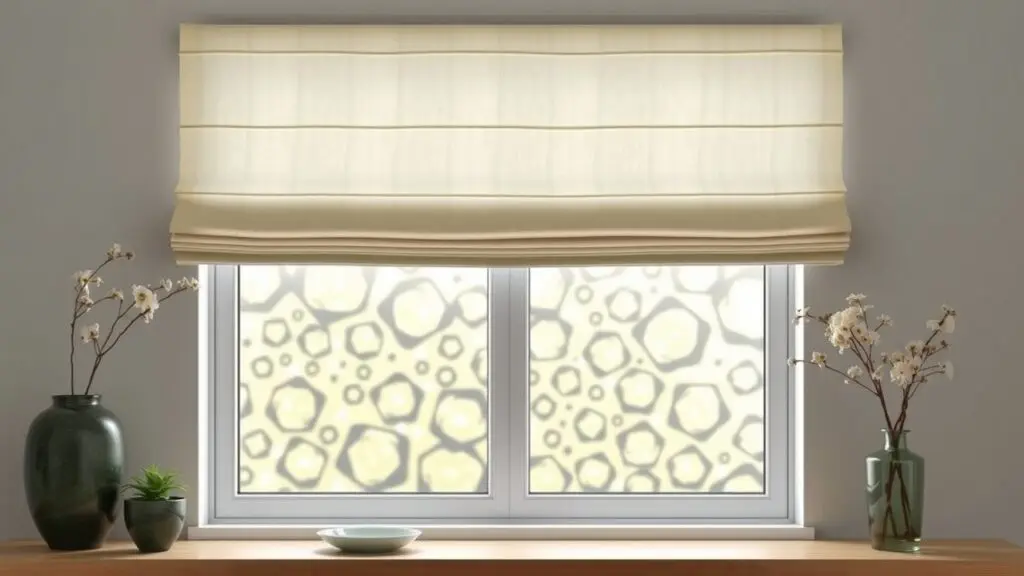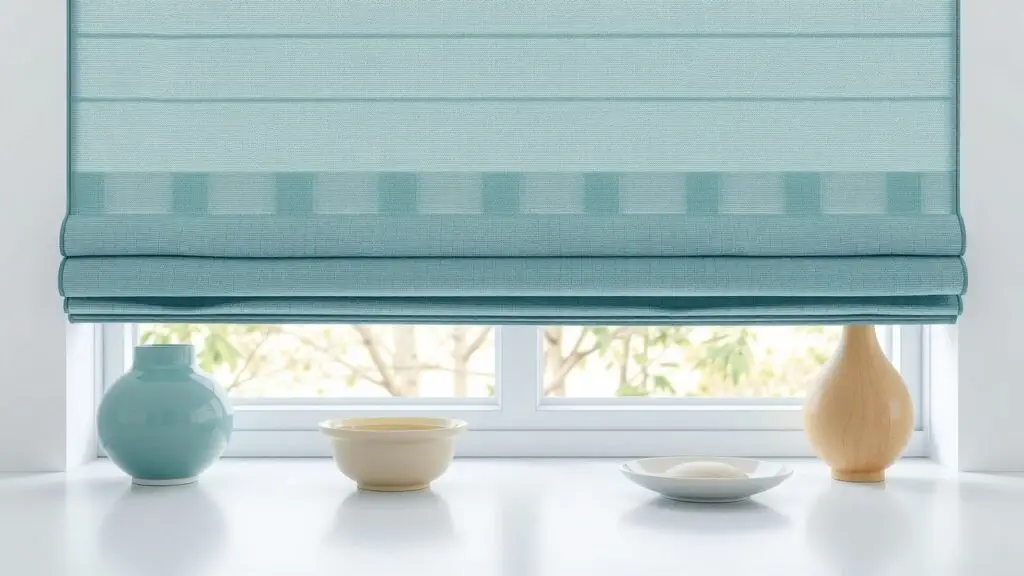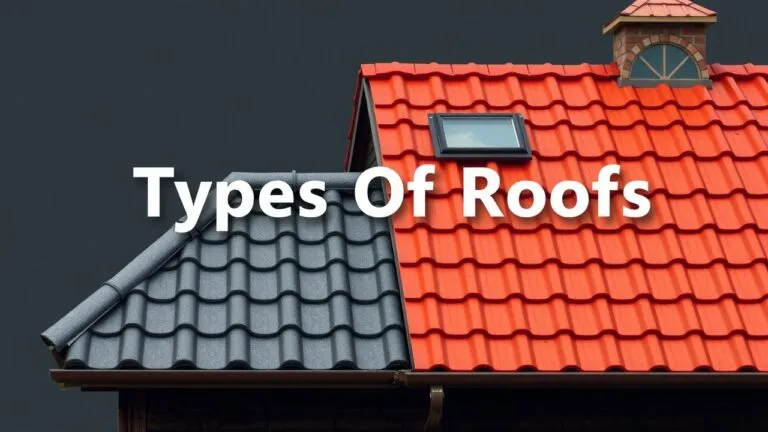Discover various types of Roman shade and their styles and materials. This guide helps you select the perfect shade, considering fabric, light filtering, and design, ensuring a great fit for your windows.
What are Roman Shades?

Roman shades are a popular type of window treatment. They are made of fabric panels that fold up neatly when you raise them. This design gives your windows a clean look. You can find many styles and materials, so they fit well with different home decor themes.
Some common types of roman shades include:
- Flat Roman Shades: These look sleek and have no extra folds when raised.
- Hobbled Roman Shades: They have soft folds that add texture.
- Relaxed Roman Shades: These have gentle curves at the bottom for a more casual style.
- Cellular/Honeycomb Roman Shades: These shades trap air inside their cells, which helps with insulation.
Each type brings its own style while serving as effective window coverings.
Why Choose Roman Shades?
There are several reasons to pick roman shades for your windows:
- Light Control: You can easily adjust them to let in just the right amount of light.
- Privacy: They provide great privacy when closed, blocking outside views.
- Insulation: Some fabrics help keep your home warm in winter and cool in summer.
- Home Decor Enhancement: With many colors and patterns available, they can match any interior design style.
These features make roman shades practical and a beautiful addition to any room.
Key Roman Shade Features
When choosing Roman shades, think about these important features:
- Lift Mechanisms:
- Corded systems let you raise or lower the shade with cords.
- Cordless options remove dangling cords for safety and ease of use, especially in homes with kids or pets.
- Motorized versions let you control the shades from a distance with a remote.
- Lining Options:
- Lined shades block more light and provide better insulation compared to unlined ones.
- Custom Options:
- Many brands offer custom sizes and designs to fit your windows perfectly.
Knowing these features will help you find the right roman shade that meets your needs.
Types of Roman Shades: A Quick Overview
Here’s a simple overview comparing some common types of Roman shades:
| Type | Description | Best For |
|---|---|---|
| Flat | Sleek design without extra folds | Modern spaces |
| Hobbled | Soft folds creating texture | Cozy environments |
| Relaxed | Gentle curve at the bottom | Casual settings |
| Cellular/Honeycomb | Energy-efficient design trapping air | Insulating rooms |
This table helps you see the main types available, so you can find the best fit for your needs!
Flat Roman Shades: Minimalist Elegance
Appearance & Mechanism
Flat roman shades look sleek and modern. They have smooth lines that create a clean, minimalist style. This makes them perfect for contemporary spaces. Unlike regular roman shades, flat ones lay completely flat when you pull them down. This not only looks good but also makes them easy to use and care for. You can find a cord system or a cordless option, which helps keep things neat.
Suitable Fabrics
When picking fabrics for flat roman shades, there are many options to choose from. Some popular choices are:
- Cotton Roman Shades: These are strong and simple to clean. They give a casual but stylish look.
- Linen Roman Shades: Linen feels natural and adds warmth to your space while staying light.
- Silk Roman Shades: For a touch of luxury, silk looks great but needs extra care because it’s delicate.
- Polyester Roman Shades: Polyester is tough and doesn’t fade easily, making it good for sunny rooms.
Choosing the right fabric matters based on how much light you want and the style you like.
Best Uses
Flat roman shades fit well in many places thanks to their flexibility. They are especially good for:
- Modern Window Treatments: Their clean design goes well with contemporary decor.
- Contemporary Spaces: Whether in bedrooms or living rooms, these shades add style without being too flashy.
- Bedroom Window Treatments: They control light nicely and bring a touch of class; you can add blackout lining if needed.
- Living Room Window Treatments: In spaces where style counts just as much as function, flat roman shades offer both privacy and charm.
Pros & Cons
Like any window treatment, flat roman shades have their ups and downs:
| Pros | Cons |
|---|---|
| Sleek design fits modern styles | Less insulation than thicker options |
| Easy to operate with corded or cordless styles | May need cleaning based on fabric |
| Flexible use in different rooms | Can cost more than basic roller shades |
Knowing these points helps homeowners decide if flat roman shades work for their homes.
Hobbled Roman Shades: Soft Folds and Casual Charm
Appearance & Mechanism
Hobbled roman shades, or soft fold roman shades, look great in any room. They have soft, flowing folds that give a cozy vibe. Unlike classic roman shades that lay flat when pulled up, hobbled ones keep their nice curves. This makes them a charming choice for your windows.
These shades work with different lift systems. You can choose corded or cordless styles. Cordless options are safer for kids and pets since there are no hanging cords. Their easy operation and stylish look make hobbled roman shades a top pick for many homes.
Suitable Fabrics
When picking fabrics for hobbled roman shades, heavier materials are best. They help the folds stay nice and provide good light control and privacy. Here are some common fabric options:
- Cotton: Strong and easy to clean; comes in lots of colors and designs.
- Linen: Has a natural feel but wrinkles easily.
- Silk: Feels luxurious and drapes beautifully but needs gentle care.
- Polyester: Cheaper, resists fading well; can look like other fabrics.
Each fabric has its good and bad points based on what you need for upkeep and style.
Best Uses
Hobbled roman shades fit well in many rooms of your house. They shine especially in:
- Bedrooms: The soft folds make the room feel warm while controlling light for better sleep.
- Family Rooms: Create a comfy space where everyone can relax.
- Living Rooms: They add class without being too fancy—perfect for hosting guests.
These window treatments work great in areas needing softer light since they spread sunlight nicely while still offering privacy.
Pros & Cons
Like all window treatments, hobbled roman shades have their upsides and downsides.
Advantages:
- Nice Look: Their unique design brightens up any space.
- Flexible Styles: Many fabric choices fit different home styles.
- Light Control: They diffuse light well while keeping your space private.
Disadvantages:
- Care Needs: Some fabrics may need more cleaning (like silk).
- Pricey Options: High-quality materials can cost more than simpler types like roller blinds.
Knowing these pros and cons helps you decide if hobbled roman shades are right for your home among various styles of roman shades available today.
Relaxed Roman Shades: Casual and Airy Ambiance

Appearance & Mechanism
Relaxed roman shades look soft and casual, adding warmth to any room. Unlike regular roman shades that fold neatly, these shades have a gentle curve at the bottom. This style creates a cozy feel. Often called soft fold roman shades, they offer a lovely design choice.
These window treatments come with different lift options, like corded or cordless. Homeowners can choose what fits their needs best. The way relaxed roman shades work is simple. When you pull the cord or use a cordless feature, the fabric folds up in soft waves instead of sharp pleats. This unique look makes them perfect for places where comfort and style are important.
Suitable Fabrics
Picking the right fabric is key to making relaxed roman shades look great. Lightweight fabrics are best because they fold easily while still looking nice. Here are some common materials you might consider:
- Cotton: This is easy to clean and very versatile.
- Linen: It has a natural texture that helps filter light.
- Silk: Silk feels fancy but needs more care.
These fabrics help with both style and how well the shade works for light control and insulation.
Best Uses
You can use relaxed roman shades in many different rooms in your home:
- Sunrooms: Their open design allows sunlight in while offering some privacy.
- Bedrooms: They help create a comfy feel without losing style; blackout lining is an option too.
- Casual Spaces: Ideal for living rooms or family areas where comfort matters most.
Using these window coverings in your home decor ideas can boost both usefulness and beauty.
Pros & Cons
Like all types of roman shades, relaxed versions have their upsides and downsides:
Advantages:
- Soft look adds warmth to any space.
- Works well in both formal and casual settings.
- Available in many colors and patterns.
Disadvantages:
- May not block all light unless lined properly.
- Can be less effective at blocking drafts compared to other styles like roller shades.
Knowing these points helps homeowners decide if relaxed roman shades fit into their home design while keeping personal preferences in mind, like light control and style choices.
Cellular/Honeycomb Roman Shades: Energy Efficiency and Light Control
Appearance & Mechanism
Cellular or honeycomb roman shades have a special design that looks like honeycombs. This design is not just pretty; it also helps save energy. The little pockets in these shades trap air, keeping your home warm in winter and cool in summer. You can pick from different light control options too! Want soft light? Choose sheer fabrics. Need total darkness? Blackout materials are the way to go.
The way you lift these cellular shades can change. Some have no cords, which makes them safer for kids and pets. Others have traditional cords, and some even use motors for a bit of techy fun!
Suitable Fabrics
When choosing fabric for roman shades, you’ll find lots of typical options. Polyester blends are common because they are strong yet soft. If you’re into being green, some places sell organic cotton options too.
But remember, there are limitations to the fabrics used for cellular shades. Thicker materials can make the insulation less effective since they don’t trap as much air in the cells.
Best Uses
Cellular/honeycomb roman shades fit great in many rooms. They are perfect for bedrooms where controlling light is super important. Blackout styles help block out that pesky morning sun so you can sleep in! Nurseries love these shades too because cordless styles keep little ones safe.
If you’re watching your energy use, you’ll really like how these insulated window treatments help keep your home comfy and may even cut down your energy bills all year round.
Pros & Cons
Just like anything else, cellular/honeycomb roman shades have good and not-so-good sides:
Advantages:
- Insulation Benefits: Their design offers great thermal insulation compared to other types of roman shades.
- Light Control Options: They come in various styles with different levels of light blockage.
- Safety Features: Cordless models are safer for kids.
Disadvantages:
- Cost Considerations: They often cost more than regular roller or flat roman shades.
- Limited Fabric Choices: Not every fabric will match every decor style since thicker fabrics can affect how well they work.
Overall, when looking at cellular or honeycomb roman shades, think about what works best for you! Weighing the good against the not-so-good can help you decide if they’re right for your home.
Choosing the Right Roman Shade Material
Fabric Considerations
Picking the right roman shade fabrics matters a lot. You want to choose materials that are durable. They should handle daily wear and tear well, especially in busy areas of your home. Different fabrics will change how much light comes in and how private your space feels. Light fabrics let in more sunlight but offer less privacy. Darker materials block out more light, giving you extra seclusion.
When it comes to maintenance, each fabric type is different. Cotton shades are usually easy to clean; a damp cloth works or you can toss them in the washing machine if you can take them off. Linen looks nice but can wrinkle easily, needing special care. Silk gives a fancy vibe but often requires dry cleaning, which can be a hassle. Polyester is budget-friendly and resists stains, making it great for homes with kids or pets.
Popular Fabric Types
- Cotton Roman Shades: These are breathable and easy to clean; they come in many colors.
- Linen Roman Shades: They feel luxurious but can wrinkle; they look nice in any room.
- Silk Roman Shades: They are soft and stylish, but need careful handling to keep looking good.
- Polyester Roman Shades: These are affordable and great at resisting stains; perfect for busy households.
- Bamboo Roman Shades: An eco-friendly choice that adds a unique look to your home while being lightweight.
Light Control Options
Light control is super important when choosing roman shades for different rooms:
- Sheer Roman Shades: These let in soft light, making them ideal for living rooms or dining areas.
- Light-filtering Roman Shades: Great for bedrooms; they provide enough privacy while still letting light in during the day.
- Room-darkening Blinds: Perfect for nurseries or media rooms since they block most light and create a comfy environment.
- Blackout Romanshades: If you need total darkness at night, these are the best choice.
Additional Considerations
Think about insulation when selecting your roman shades if keeping energy costs down matters to you. Insulated roman shades help keep your home cozy by blocking heat in winter and keeping it cool during summer.
Waterproof materials can also be smart if you’re looking for shades for kitchens or bathrooms where there’s often moisture. These options resist humidity damage while still looking good.
By learning about different roman shade materials and their benefits, you’ll make better choices that enhance both style and function in your home.
Roman Shade Installation, Care, and Maintenance

Measuring for Roman Shades
Measuring for roman shades is super important. It helps you get the right fit. Here’s how to do it:
- Measure the Width: Measure your window at three points: the top, middle, and bottom. Take the smallest width to make sure it fits.
- Measure the Height: Measure from the top of the window to where you want the shade to stop. Do this at three spots: left side, center, and right side. Use the longest measurement.
- Consider Mounting Options: Decide if you want an inside mount (fits inside the frame) or an outside mount (hangs over). This will change how you measure.
- Record Your Measurements: Write down everything neatly so you don’t forget when ordering custom roman shades.
Getting correct roman shade measurements is key for a good fit.
Installation Options
You have a few choices for installing roman shades based on your skills and what you like:
- DIY Roman Shades: If you’re good with tools and like projects, try putting them up yourself! Many brands give easy instructions that help with DIY installation.
- Professional Installation: If your windows are tricky or if you just want it done fast, getting a pro might be best. They know all about different mounting options to make sure things fit just right.
- Mounting Options:
- Inside Mounts look neat but need accurate measuring.
- Outside Mounts can block more light but may require extra space around your windows.
DIY vs. Professional Installation
Think about whether to go DIY or hire a pro based on your comfort level:
- DIY Projects: Good for folks who want to save money and are willing to learn new skills.
- Professional Window Treatments Installation: Best if you’re short on time or unsure about using tools; pros make sure everything’s secure without messing up walls.
Considerations for Different Window Types
Different window shapes need special attention when picking roman shades:
- Large Windows: Use wider fabric panels that create nice folds when raised.
- Small Windows: Pick lighter fabrics that won’t overpower tiny spaces but still look good.
- Arch Windows: You’ll need custom-shaped roman shades here; these often require special orders because of their shape.
- Bay Windows: Use separate panels tailored for each section; this gives you flexibility in design.
Cleaning and Maintenance
Taking care of your roman shades helps them last longer:
- Dust them regularly with a soft cloth or a vacuum attachment meant for delicate things.
- For deeper cleaning based on fabric:
- Look at labels first; cotton can usually be machine washed, while silk often needs dry cleaning.
- Stay away from strong chemicals that could harm fabrics over time; instead, use gentle detergents recommended by manufacturers.
Fabric-Specific Care Instructions
| Fabric Type | Care Instructions |
|---|---|
| Cotton | Machine wash cold; tumble dry low |
| Silk | Dry clean recommended |
| Linen | Spot clean only; avoid too much moisture |
General Tips for Longevity
To help prevent damage over time:
- Keep cords out of reach from kids or pets.
- Check regularly after bad weather.
- Change how you use them sometimes so one area doesn’t wear out faster than another.
Following these steps will keep your roman shades looking nice and working well in any room!
Frequently Asked Questions (FAQs)
What types of fabrics are best for roman shades?
Popular fabrics for roman shades include cotton, linen, silk, and polyester. Cotton is durable and easy to clean. Linen offers a natural texture. Silk adds elegance but requires careful handling. Polyester is budget-friendly and resists stains.
How do roman shades compare to other window treatments?
Roman shades offer a sleek look and versatile design. They differ from roller shades by providing a more tailored appearance. Compared to curtains, they fit tightly and can offer better light control.
What should I consider when choosing roman shades for my bedroom?
Select fabric that provides good light blocking for better sleep. Blackout or room-darkening options work well in bedrooms. Choose colors that match your decor.
How can I care for my roman shades?
Regularly dust your roman shades with a soft cloth or a vacuum attachment. Depending on the fabric, some can be machine washed while others need dry cleaning.
What is the difference between corded and cordless lift systems?
Corded systems use strings to raise or lower the shade. Cordless options are safer for homes with children or pets as they eliminate dangling cords.
Customizing Roman Shades for Your Home
- Valance Options: Add valances for a polished look.
- Lining Choices: Choose lining options based on light control needs.
- Fabric Selection: Opt for eco-friendly fabrics like bamboo or organic cotton.
- Mounting Types: Decide between inside or outside mounts based on your window style.
- Repair Needs: Learn simple steps for basic repair of damages.
- Energy Efficiency: Look into energy-efficient materials to save on bills.
- Design Ideas: Explore layered designs for added depth in decor.
- Smart Home Integration: Consider motorized options compatible with smart home devices.
Related Topics
- Types of Roman Shade Fabrics
- Types of Roman Shade Lift Mechanisms
- Types of Roman Shade Lining Options
- Types of Roman Shade Mounting Options
- Types of Window Treatments
- Types of Roman Shade Installation Methods



Types of Roman Shades: A Complete Guide to Styles & Materials